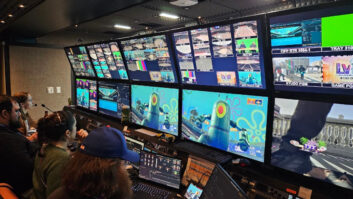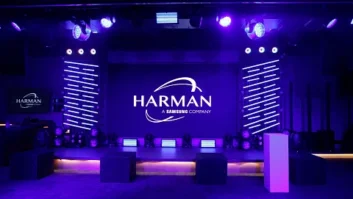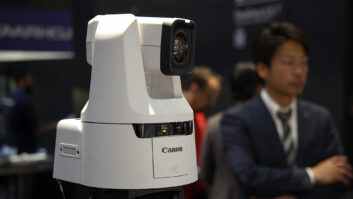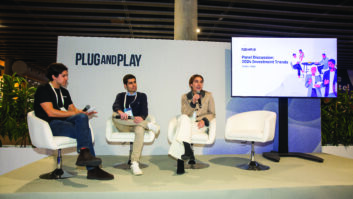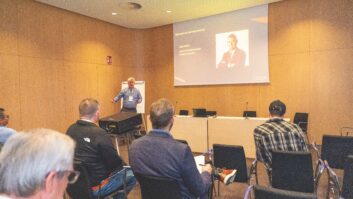The legacy of the pandemic in terms of how we work and how we think about work has been widely commented upon. Similarly, there has been much discussion about the ways in which organisations operate and large events are staged – and festivals, it seems, are no exception.
“I do think that [the pandemic shutdown] provided a chance to reset things in the festival market,” says Ben Payne, director of lighting at manufacturer Martin EMEA. “So in the case of lighting, we have seen a move towards the use of LED products and higher IP ratings” – IP ratings being the classification for the degree of protection provided by an enclosure.
Ultimately, it is probable that solutions with these characteristics will complement two overriding trends shaping festival futures: the need to reduce energy consumption as part of a defined decarbonisation strategy; and the imperative to protect lighting as much as possible as extreme weather – linked to climate change – becomes more frequent.
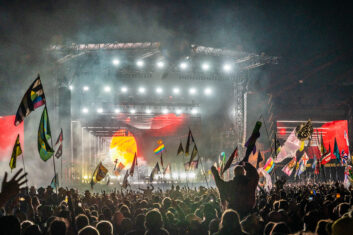 Payne doesn’t think there was ever much doubt that demand from festivals and concerts was going to return – although he has been pleasantly surprised by the rate of the resurgence. “It’s a natural human desire to be entertained, even during bad times,” he says. “Personally, I had a belief that rental companies would be more cautious and would want to see an ROI from their investments in 2018 and 2019. [But in fact] there has been a very big drive [across this market] to come back strongly and invest in new products.”
Payne doesn’t think there was ever much doubt that demand from festivals and concerts was going to return – although he has been pleasantly surprised by the rate of the resurgence. “It’s a natural human desire to be entertained, even during bad times,” he says. “Personally, I had a belief that rental companies would be more cautious and would want to see an ROI from their investments in 2018 and 2019. [But in fact] there has been a very big drive [across this market] to come back strongly and invest in new products.”
ACCELERATED SHIFT
In which context it’s not difficult to see why the shift towards LED lighting has continued to accelerate. Not only is it more efficient in terms of energy consumption, it also affords a far longer lifecycle, so costs related to maintenance, upgrade and repair are significantly lower.
“There has been a big drive on the eco side of products, which means customers [are inclined to move] from lamp-based lighting into the LED world,” says Payne, adding that rental companies and organisers are acting on the recognition of the “global responsibility” to help decarbonise their industry: “This has translated to event companies and suppliers. For example, the [Birmingham 2022] Commonwealth Games was done as a carbon-neutral event, and that approach is now becoming more common.”
For Martin, it is the MAC Ultra Performance that is currently leading its presence in festival lighting. Built to support the largest live events, the product is based on Martin’s 1150W, 5800K proprietary LED light engine, with the fixture pushing 46,500 lumens in projection. The 50,000+ hour light engine also provides high resolution, strobing and Martin’s Animotion effect, which supports the creation of innovative beam animations.
PERFORMANCE BASED
This emphasis on performance and multi-faceted effects is evident throughout the market. For example, Clay Paky recently introduced Volero Wave, an LED bar comprising independent moving bodies. Each of the separate heads is independently capable of moving on a 220-degree tilt, giving rise to impactful three-dimensional, volumetric projections.
“The innovative concept behind Volero Wave, as well as the main challenge for the Clay Paky R&D team, was to be able to move the entire light source on its axis, thus preserving the same intensity of the light flux in any position of the tilt range,” states the company on its website.
“The beams always appear extremely sharp and collimated, parallel to each other thanks to the 2.9-degree projection angle,” it goes on. “The synchronised movement produces an impressive wave of light, [which is] all the more overwhelming the more Volero Wave fixtures are seamlessly connected to each other.”
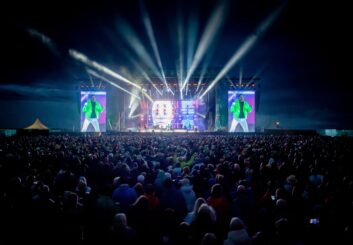 LED lighting products that can support different connectivity and networking requirements are also in-demand. An example, the ETC Series Four LED Series 3, which includes the Lustr X8 array for the most nuanced colours and the Daylight HDR array for tunable white light. Connectivity options include wireless DMX/RDM via the integration of City Theatrical’s Multiverse protocol, while easy NFC – which involves short-range wireless connectivity – can be achieved using a regular mobile device installed with ETC’s Set Light app.
LED lighting products that can support different connectivity and networking requirements are also in-demand. An example, the ETC Series Four LED Series 3, which includes the Lustr X8 array for the most nuanced colours and the Daylight HDR array for tunable white light. Connectivity options include wireless DMX/RDM via the integration of City Theatrical’s Multiverse protocol, while easy NFC – which involves short-range wireless connectivity – can be achieved using a regular mobile device installed with ETC’s Set Light app.
GENERAL SHIFT
All of which suggests a general shift in favour of lighting systems that are not only efficient, but also easy to control and versatile of effect. It’s probable that raised expectations when it comes to show production – especially for headline artists – is also a contributory factor.
“There is a great deal of emphasis on giving as many features as you can to a product,” confirms Payne. “When I first started in lighting about 20 years ago, a moving light could change colour, accept a few gobos, and pan across the stage. But now [a big drive of product design] is to give the rental house – and LDs – the greatest possible versatility, which means the look of every [performance/event] can be different.”
Hence it’s more likely that a new lighting product today will be able to deliver between 20 and 50 distinctive looks. “That’s good for rental houses in terms of the ROI, and good for the lighting designer who has the most flexibility in terms of delivering what the artist wants,” adds Payne.
Michael Gräf, technical sales specialist at German professional AV supplier Thomann, points to a continued rise in dedicated outdoor fixtures that can help “decrease maintenance, logistical costs, and the number of working hours required.” This also means that a push towards smaller and lighter fixtures, where possible, is to be expected.
“Saving money on transport and working time will always be an issue,” says Graf. “At the moment many [outdoor] fixtures are more expensive, bigger and heavier compared to indoor models (ignoring cases, etc). But I think it’s just a matter of time, and in fact they [are already becoming] smaller and less heavy.”
CLIMATE CHANGE
Others we spoke to off the record for this article alluded to an increased emphasis on lighting protection, and the safe money is on that continuing as festival operators and rental houses prepare to negotiate their next major challenge: climate change.
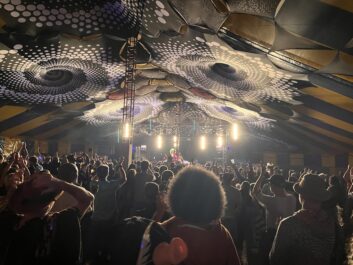 Already wounded by the Covid hiatus, stakeholders in some countries are beginning to lobby for a climate ‘safety net’ as events begin to be hit more regularly by extreme weather. This has been especially apparent in Australia, where more than a dozen festivals were cancelled in 2022 due to heavy rain and storms linked to changes in La Niña weather patterns.
Already wounded by the Covid hiatus, stakeholders in some countries are beginning to lobby for a climate ‘safety net’ as events begin to be hit more regularly by extreme weather. This has been especially apparent in Australia, where more than a dozen festivals were cancelled in 2022 due to heavy rain and storms linked to changes in La Niña weather patterns.
In this context, it is even more logical that rental companies are emphasising durability and protection when making new investments. Moreover, it’s bound to be a contributing factor in the trend towards more smaller events in future – something that is also being prompted by challenges in the recruitment of technical personnel.
SKILLS SHORTAGE
“There is a massive skills shortage in terms of crew,” confirms Payne. “So it’s actually becoming more difficult to produce bigger festivals as [sufficient] resources aren’t always there to do them. Then there is the cost of living issue: big festivals equal large costs and ticket prices. That’s not such a problem with smaller events, so I do think we will
see more of them.”
With a strong summer of festivals ahead across the globe – including a number of innovative new formats – there is plenty of reason to expect that this sector will continue to feed AV manufacturers and rental companies alike, with ecological lighting at the forefront of efforts to go greener.
